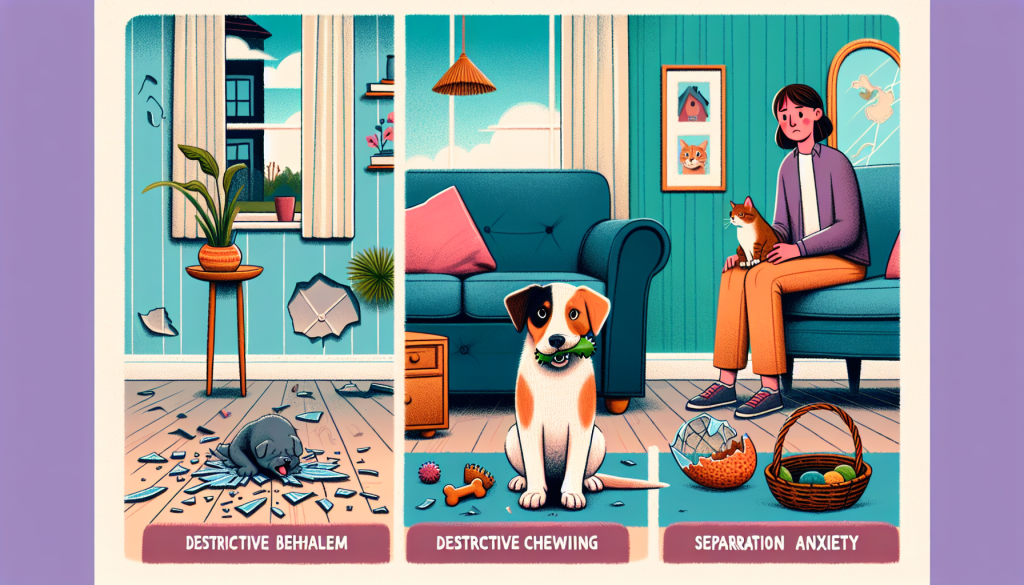Have you ever wondered why your beloved furball acts out sometimes? From excessive barking to destructive chewing, pets can exhibit various behavioral problems that can be frustrating for both them and their owners. In this article, we will explore some of the most common behavioral issues seen in pets and provide you with practical tips and strategies to address them. By understanding the underlying causes and implementing effective solutions, you can create a harmonious and happy environment for both you and your furry friend.
Table of Contents
ToggleAnxiety
Separation anxiety
Separation anxiety in pets is a common behavioral problem characterized by a strong fear or distress when the pet is separated from their owner or left alone at home. Pets with separation anxiety may exhibit excessive barking, destructive behavior, house soiling, and even attempts to escape. To address separation anxiety, it is important to gradually desensitize the pet to being alone by increasing the time intervals of separation, providing them with interactive toys or puzzles, and creating a safe and comfortable space for them when left alone.
Noise anxiety
Noise anxiety is another form of anxiety often seen in pets, where they display fear or anxiety in response to loud noises such as thunderstorms, fireworks, or even everyday sounds like doorbells. Pets with noise anxiety may tremble, hide, pace, or exhibit destructive behavior during these loud events. To help manage noise anxiety, it is recommended to create a safe and secure space for your pet during noisy situations, such as a designated room with soft music or white noise to mask the sounds. Additionally, using pheromone diffusers or anxiety wraps can also provide a calming effect.
Social anxiety
Pets can also experience social anxiety, where they feel uncomfortable or fearful in social situations or around unfamiliar people or animals. Social anxiety may manifest as fear-based aggression, excessive barking, or avoidance behavior. To help your pet overcome social anxiety, gradual exposure to new people, animals, and environments is essential. Positive reinforcement techniques, such as rewarding your pet for calm behavior and providing them with treats or praise during social interactions, can also help build their confidence and reduce anxiety.
Aggression
Territorial aggression
Territorial aggression occurs when pets display aggression towards other animals or people who enter their perceived territory. This behavior is commonly seen in dogs and is often triggered by a strong desire to protect their home or belongings. To address territorial aggression, it is important to establish yourself as the pack leader and provide clear boundaries for your pet. Gradual introductions and positive reinforcement techniques can also help them learn that new people or animals are not a threat to their territory.
Fear-based aggression
Fear-based aggression is rooted in a pet’s fear or anxiety and can be triggered by specific situations or stimuli. Pets exhibiting fear-based aggression may display body language such as cowering, growling, or biting when confronted with their fears. It is important to identify the triggers for your pet’s fear-based aggression and work on desensitizing them through gradual exposure and positive reinforcement training. Seeking guidance from a professional animal behaviorist or trainer can also be beneficial in managing fear-based aggression.
Resource guarding aggression
Resource guarding refers to the aggressive behavior displayed by pets when they protect their valued possessions, such as food, toys, or even a specific place. Pets with resource guarding aggression may growl, snap, or even bite when someone approaches their guarded items. To address resource guarding aggression, it is crucial to establish yourself as the provider and leader, ensuring that your pet trusts you and understands that you are not a threat to their resources. Gradual desensitization exercises and the use of positive reinforcement techniques can help your pet learn that sharing and cooperation are positive experiences.
Excessive Barking
Attention-seeking barking
Attention-seeking barking is a common behavioral problem where pets bark excessively to gain attention from their owners or others. This behavior is often seen in dogs who have learned that barking elicits a response or attention. To address attention-seeking barking, it is important to reinforce quiet behavior and provide your pet with alternative ways to seek attention, such as through interactive toys or playtime. Consistency in training and positive reinforcement techniques will help your pet understand that barking is not the way to get attention.
Fear or anxiety-based barking
Fear or anxiety-based barking is a response to perceived threats or triggers that provoke fear or anxiety in pets. This type of barking can occur in situations such as encountering strangers, loud noises, or unfamiliar environments. To manage fear or anxiety-based barking, it is important to identify the underlying cause and help your pet feel safe and secure. Providing them with a quiet and comfortable space, using calming aids such as pheromone diffusers, and employing positive reinforcement training techniques can help reduce fear and anxiety and mitigate the barking behavior.
Boredom-induced barking
Boredom-induced barking is common in pets that do not receive sufficient mental or physical stimulation. Dogs, in particular, are prone to barking out of boredom. To address boredom-induced barking, it is important to provide your pet with regular exercise, playtime, and mental stimulation. Interactive toys, puzzle feeders, and daily walks or outdoor activities can help alleviate boredom and reduce barking. Additionally, crate training and providing a comfortable den-like space can also discourage excessive barking when your pet is left alone.
Destructive Behavior
Chewing
Chewing is a natural behavior for pets, especially puppies, but it can become a problem when they target inappropriate items such as furniture, shoes, or household objects. To address chewing behavior, it is important to provide your pet with appropriate chewing alternatives, such as toys or bones designed specifically for this purpose. Consistent supervision, redirection, and positive reinforcement when they chew on appropriate items can help train them to distinguish between acceptable and unacceptable chewing habits.
Digging
Digging is another common destructive behavior seen in pets, particularly dogs. Dogs may dig for various reasons, including boredom, a desire to escape, or even to create a comfortable resting spot. To discourage digging, it is important to provide your pet with alternative outlets for their energy and natural instincts. Regular exercise, mental stimulation, and designated digging areas in the yard can help redirect their digging behavior. Additionally, utilizing deterrents such as covering the preferred digging sites with gravel or placing obstacles can help discourage digging in undesirable areas.
Scratching
Cats, in particular, have a natural instinct to scratch, which serves multiple purposes including stretching and marking territory. However, excessive scratching can lead to damage furniture, carpets, or other household items. To address scratching behavior, it is important to provide your cat with appropriate scratching posts or boards and encourage their use through positive reinforcement, such as treats or praise. Trimming your cat’s nails regularly and providing them with adequate mental and physical stimulation can also help reduce excessive scratching.
House Soiling
Inappropriate urination
Inappropriate urination is a common behavioral issue in both cats and dogs and can often be a result of underlying medical conditions. If your pet is consistently urinating in inappropriate places, it is essential to rule out any medical issues with a visit to the veterinarian. Once medical issues have been addressed, it is important to establish a regular toileting routine for your pet and provide them with easy access to appropriate outdoor elimination areas. Consistent positive reinforcement and rewarding them for appropriate toileting behavior can help prevent future accidents.
Marking
Marking is a natural behavior in dogs and cats, where they use urine to mark their territory. However, excessive marking, especially indoors, can become a problem for pet owners. To address marking behavior, it is important to spay or neuter your pet, as this can reduce their desire to mark. Consistency in training and supervision can help redirect marking behavior, while providing your pet with ample opportunities for bathroom breaks outside can help prevent indoor marking incidents.
Defecating indoors
Indoor defecation can be a sign of stress, anxiety, or even a lack of proper house training in pets. If your pet is consistently defecating indoors, it is important to establish a regular feeding and bathroom schedule to regulate their bowel movements. Positive reinforcement and rewards for appropriate elimination behavior can also help train your pet to defecate in appropriate outdoor areas. If stress or anxiety is a contributing factor, it may be helpful to create a calm and secure environment for your pet and seek professional advice if the behavior persists.
Compulsive Behaviors
Excessive grooming
Excessive grooming is a common compulsive behavior observed in both cats and dogs. Pets may engage in repetitive licking or grooming to the point of causing hair loss or skin irritation. Excessive grooming can be triggered by stress, boredom, or even underlying medical issues. To address excessive grooming, it is important to identify and address any underlying medical conditions with the help of a veterinarian. Providing your pet with environmental enrichment, such as interactive toys, regular playtime, and a consistent daily routine, can also help alleviate stress and redirect the compulsive grooming behavior.
Tail chasing
Tail chasing is a compulsive behavior often observed in dogs, especially certain breeds like Bull Terriers or German Shepherds. It can be triggered by boredom, frustration, or even obsessive-compulsive tendencies. To address tail chasing behavior, it is important to provide your dog with regular exercise, mental stimulation, and structured activities. Redirecting their attention to interactive toys or engaging in positive reinforcement training can help distract them from the tail chasing behavior. Seeking guidance from a professional animal behaviorist is recommended for severe cases.
Paw licking
Paw licking or chewing is a compulsive behavior commonly seen in both dogs and cats. Excessive licking or chewing of the paws can result in skin irritation, inflammation, or even infection. This behavior can be triggered by allergies, boredom, anxiety, or pain. To address paw licking behavior, it is important to identify and address any underlying medical issues with the help of a veterinarian. Environmental enrichment, such as interactive toys or puzzle feeders, can help alleviate boredom and redirect their focus away from excessive paw licking. Additionally, using deterrents like bitter sprays on the paws can discourage this behavior.
Jumping Up
Greeting behavior
Jumping up is often seen as a greeting behavior in dogs, where they try to reach the attention of their owners or visitors by jumping up on them. While this behavior may seem harmless, it can become a problem when it is uncontrolled or bothersome. To address jumping up behavior, it is important to establish consistent rules and boundaries for your pet. Encouraging them to sit or stay instead of jumping up and rewarding calm behavior can help train them to greet people politely. Consistency in training and avoiding unintentional reinforcement of the jumping behavior will aid in breaking this habit.
Attention-seeking behavior
Similar to greeting behavior, some pets may resort to jumping up as a means of seeking attention from their owners. They have learned that this behavior yields the desired response. To address attention-seeking jumping up, it is crucial to provide your pet with alternative ways to seek attention, such as sitting or offering a toy. Ignoring or turning away from the pet when they jump up can help discourage this behavior, while rewarding appropriate behavior will reinforce the desired response. Consistency in training and clear communication will aid in modifying attention-seeking jumping up habits.
Fearfulness
Loud noises
Many pets are fearful of loud noises such as thunderstorms or fireworks. This fearfulness can lead to anxious behaviors such as trembling, hiding, or excessive barking. To alleviate fearfulness around loud noises, it is important to create a safe and comforting environment for your pet during these occasions. Providing a secure space where they can retreat, such as a crate or a designated room with familiar smells, can help them feel more secure. Using pheromone diffusers or playing calming music can also help mask the loud noises and reduce their anxiety.
New environments
Pets may experience fearfulness when introduced to new environments or situations, especially if they are not adequately socialized. To help your pet overcome fearfulness in new environments, gradual exposure is key. Begin by introducing them to new places or situations in a controlled and positive manner, rewarding them for calm and relaxed behavior. Gradually increasing the level of difficulty or exposure can help build their confidence and reduce their fearfulness. Seeking the assistance of a professional animal behaviorist can be beneficial in facilitating this process.
Strangers
Some pets may exhibit fearfulness or anxiety when encountering strangers, whether it be visitors to the home or strangers encountered during walks. This fearfulness can manifest as barking, growling, or withdrawal behavior. To address fearfulness towards strangers, it is important to gradually expose your pet to new people in controlled and positive situations. Encouraging calm behavior, using treats or praise as rewards, and avoiding forceful or negative interactions will help build your pet’s confidence and reduce fearfulness. Consistency in training and patience are key to successfully addressing this behavior.
Escaping
Fence jumping
Pets, especially dogs, may attempt to escape their confined spaces by jumping over fences. This behavior can be dangerous and put your pet at risk of injury or getting lost. To address fence jumping behavior, it is important to ensure that your fence is secure and free from any escape routes. Increasing the height of the fence or adding extensions can help discourage jumping. Providing your pet with plenty of exercise, mental stimulation, and attention can also help reduce their desire to escape by addressing any underlying boredom or anxiety.
Digging under fences
Pets may also attempt to escape by digging under fences, especially if they are seeking adventure or chasing after something. To address this behavior, it is important to reinforce boundaries and ensure your fence is secured underground as well. Using deterrents such as chicken wire or burying rocks along the fence line can deter digging behaviors. Providing your pet with ample exercise and mental stimulation can also help reduce their desire to escape. Supervision and redirection are essential in breaking the habit of digging under fences.
Leash Reactivity
Aggression towards other dogs
Leash reactivity refers to aggressive behavior displayed by pets when encountering other dogs while on a leash. This behavior can stem from fear, anxiety, or a desire to protect their owner. To address aggression towards other dogs while on a leash, it is important to employ positive reinforcement training techniques and gradually expose your pet to other dogs in a controlled and positive manner. Teaching your pet to focus on you and rewarding calm behavior can help redirect their attention away from other dogs. Seeking the guidance of a professional animal behaviorist or trainer can provide additional support and guidance.
Barking/lunging at strangers
Leash reactivity can also extend to barking or lunging at strangers encountered during walks. This behavior may come from a sense of fear, anxiety, or territoriality. To address barking or lunging at strangers, it is important to establish yourself as the pack leader and maintain control of the situation. Consistency in training, using positive reinforcement, and rewarding calm behavior can help your pet learn appropriate behavior when encountering strangers. Gradual exposure to new people and maintaining a safe distance during encounters will aid in reducing anxiety or fear-based reactions.
Intense pulling on the leash
Intense pulling on the leash is a common issue during walks and can make the experience unpleasant for both pets and owners. To address leash reactivity associated with pulling, it is important to teach your pet loose leash walking through positive reinforcement techniques. Encouraging your pet to walk beside you and rewarding them for walking without excess tension on the leash can help modify their behavior. Consistency in training, using appropriate walking equipment such as front-clip harnesses, and providing mental and physical stimulation before walks can help reduce the intensity of pulling on the leash.








